 |
||
|
|
||
HinduOfUniverseGOKULASHTAMI (August-September)
Maha Vishnu took various avatars to protect the mortal world from the evildoers and sinners. One such incarnation was his birth as the child of King Vasudeva and Queen Devaki Devi. Gokul Ashtami is the birthday of Lord Krishna. It falls on the 8th day of the dark half of the month of 'Bhadrapada' (August-September) and is one of the greatest of all Hindu festivals. Lord Krishna was born at midnight. A twenty-four hour fast is observed on this day, which is broken at midnight. The festival is called in different names as "Krishna Jayanti", "Janma Ashtami", "Krishnaashtami" , "Gokul Ashtami", and as "Sri Jayanti". Birth of Lord Krishna The myth connected to the birth of Lord Vishnu is as follows. Vasudeva was the chief of 'Shooras' and married Devaki one of the seven daughters of Devaka. They were very happy, for none had ever seen so fine a man and a wife matched in such perfect harmony. People treat this day as one of very great rejoicing. There is recitation of the "Bhagavatam", singing and praying everywhere. Temples are decorated for the occasion, Kirtans are sung, bells are rung, the conch is blown, and Sanskrit hymns are recited in praise of Lord Krishna. At Mathura, the birthplace of Lord Krishna, special spiritual gatherings are organised at this time. Pilgrims from all over India attend these festive gatherings. People observe a daylong fast, which is broken only at midnight, the time when Krishna is believed to have been born. The festival is a community celebration, and people visit Krishna temples, which are specially decorated and lit for the occasion. On the occasion of 'Gokulashtami', we can find kids forming a human pyramid to reach the pot full of curds (dahi-handi) and break it. A little before midnight, devotees pour into temples to participate in the special 'Arati' and to relive the birth of Krishna. Till midnight, devotional songs are sung in anticipation of the holy birth. Special cradles are installed at temples and a small statue of the "Balgopal" is placed in them.
MAKAR SANKRANTI (January)
Makar Sankranti usually falls on 14th of January every year. This festival is one of the many festivals which have been celebrated since the vedic period. On this day the sun comes across the north of equator. On this very day it is believed that 'the morning' of the deities commences. This particular period, when the sun is positioned across the north of equator has been considered as an 'accomplishment giving period' by the scholars. Even Astrology endorses this fact and this period is supposed to be auspicious for the various activities like construction of the houses, performance of oblations, establishment of the deities etc. This period is considered to be so auspicious, that if a person dies during this period he is supposed to attain liberation. The sun's position towards the north of equator signifies the arrival of spring season and the end of winter season. The day starts to prolong. On this occasion, all the pilgrimage sites & holy rivers are the thronged by the devotees. At Ganga-Sagar an inland emerges by the grace of deity Varun, which remains for a week and ultimately gets submerged into the sea. The scriptures narrate about the greatness of taking a holy dip on the occasion of Makar Sankranti. After taking the bath it is customary to eat food articles prepared from sesame seeds and 'Kichadi' (rice and pulse cooked together). Making donation of sesame seed is also considered as very auspicious. Makar Sankranti usually comes in the Hindu month of 'Magha'. The term 'Magha' is derived from the sanskrit word 'Magh' which means wealth i.e. gold, silver, apparels, ornaments etc. This month has been named as 'Magha' because it is considered to be the month of making donations of the above mentioned things. In Punjab people celebrate it as 'Lohadi' a day before 'Makar-Sanskranti'. On this day the people of Punjab offer maize, 'Revadi' (prepared from sesame seeds), in the fire, amidst the singing of folk songs. In Gujarat and Maharashtra people decorate their houses with 'Rangoli'. They eat food prepared from sesame seeds and jaggery. There is a saying in Maharashtra connected with this day which goes as follows- 'TIL GUD GHYA ANI GARUD GARUD BOLA.' Meaning; (Take sesame and jaggery and speak sweetly.) Women of Maharashtra attired in beautiful apparels visit the houses of their relatives and friends, where they are welcomed with 'Kheel' and 'Porridge'. The hosts honour them by applying 'Kumkum'. The festival of Makar Sanskranti is celebrated as 'Pongal' in Tamil Nadu and Andhra Pradesh. On this occasion people decorate the idols of deities. Cultural programmes are organised to mark this occasion. 'Pongal' (Khichadi) is offered to the deities and then it is taken as prasadam. During the ancient time, the third stage of the study of the Vedas commenced on this day. People used to send their wards to the 'Gurukula' after performing the sacred thread ceremony of children. On Vasant Panchami, which falls some days later, the worship of 'Saraswati' signifies the importance of the commencement of new learning session. In the south, people still continue with the tradition of initiating their children into the study of Vedas, on this day. VASANT PANCHAMI (January)
On the fifth day of the Shukla Paksha (Waxing moon of fortnightly) of the Magha month, coming of spring is celebrated. This is known as Vasant Panchami. During this flowering and blossoming season one can listen distinctly to the kooing of the Koel (bird) and the entire ambiance becomes very beautiful. On this day one should dress up in beautiful attire and worship Lord Vishnu. On this day Brahmins should be offered food. Pitru-Tarpan (liberation of deceased ancestors) can also be performed on this day. One can also worship Goddess Saraswati.In the coming of Spring, God of Love(Kamadev) and his wife Rati are also prayed and worshipped on this auspicious occasion. It is on this day when Abeer and Gulal are played with and songs of Holi are sung till Phalgun Poornima.All rejoice while celebrating this auspicious occasion. HOLI (March)
Holi, which falls on the full moon day, in the Hindu month of 'Falgun', is the last major festival of the year. People celebrate this festival with enthusiasm and without making any discrimination between rich and poor, high and low. It is very difficult to state, when this festival started, but the name of 'holikotsav' had been mentioned even in the Vedas and the Puranas. So 'holikotsav' has been celebrated since the Vedic period. During the ancient time, oblation was offered to the sacred fire of the Holi, amidst the chanting of the Vedic mantra.This mantra was chanted with the specific wish of destruction of the demon. On this very day Vaishwadev oblation commenced in which offerings of wheat, gram and Oat were made to the sacrificial fire. In Sanskrit language, the fried cereals are called 'Holka'. Holikotsav is named after it. Even today we continue with the tradition of offering wheat and oat into the Holika fire. In due course of time, the form of this festival got transformed, due to numerous social influences and ultimately ended up in the form as we celebrate it today. According to the Narad Puran, this day is celebrated in the memory of Prahlad's victory and the defeat of his father's-sister 'Holika'. Hiranyakashipu - the father of Prahlad has instructed his sister Holika to sit in the burning fire with Prahlad in lap. She was blessed a boon, as a result of which no fire could burn her. But the opposite happened, Prahlad survived and Holika was charred to death. Thus 'holi' is celebrated to commemorate the victory of virtue over evil. There is also an another incident related with the celebration of 'Holi', which has been mentioned in the 'Bhavishya Puran'. During the reign of king Raghu, people were tormented by a giant named 'Dhundha'. Sage Vashishth advised them to terrorize her by burning fire at as many places as they could. Thus they got rid of the giant. Even today we see children making mischief on the day of 'holikotsav. The mention of this festival in Jaimini Mimansa goes to prove its antiquity. A stone incription belonging to 300 BC found at Ramgarh in the province of Vindhya, had mentioned of Holikotsav on it. King Harsha has mentioned about holikotsav in his work Ratnavali that was written during the 7th century. The famous Muslim tourist - Ulbaruni too has mentioned about holikotsav in his historical memories. Other Muslim writes of that period have mentioned, that holikotsav were not only celebrated by the Hindus but also by the Muslims. Thus we see that the tradition of celebrating holikotsav has been continuing since Vedic period without any hindrance. This festival unites all the Indian's in a tremendous way. Holi is the festival of the colours. But very few people are aware of the impacts the colours have on our body and on our health. Western-Physicians and doctors believe that for a healthy body, colours too have an important place besides the other vital elements. Deficiency of a particular colour in our body causes ailment, which can be cured only after supplementing the body with that particular colour. On Holi, people after enjoying themselves with the colours, take bath and then go to meet their relatives and friends. Discrimination is not made even with the enemy. The concept of enemy does not exist on this day. There is no difference between rich and poor on this day. The concept of New Year (Samvatsar) varies in the different provinces of our country. In some provinces, the month commences from the 'Krishna-Paksha' on the other hand in some provinces it commences from 'Shukla-Paksha'. For the former the year ends on 'Purnima' of the month of Phalgun. The new years begins next day - Chaitra, 1st day of the Krishna Paksha. For them on this day the last year has died. For this reason in some provinces like Bihar and UP. Holika dahan is also called 'Samvatsar dahan? On this day all the bitterness and evil memories of the last year are burnt in the fire and the New Year is begun with a celebration. RAM NAVAMI (April)
Ram Navami is celebrated in the Hindu month of Chaitra and on the ninth day of the bright lunar phase, to commemorate the birth anniversary of Sri Ram. The incarnation of Sri Ram materialized on this very day, to show the path of virtuosity and truth to the mankind, who had lost its way by establishing the high standards of moral values and ideals. Sri Ram - the founder of Ram Rajya faced al the problems of life with courage and righteousness. Ramayan contains descriptions of all types of relation, which a man normally has in his life, like teacher-student, mother-father, Brother-sister in law, Husband-wife, friend-enemy, master-servant etc. The incidents described in Ramayan contain such high moral-value and ideals that they seems unbelievable and imaginary, but the fact remains that they are undoubtedly true. Ram Navami is our national and cultural festival. In the present time, when there is a tendency of greed, selfishness prevalent among the common people, when the relation between family members has reached its lowest ebb, Ram Navami inspires us to reach that highest & idealistic pedestal, which was occupied by Sri Ram. HANUMAN JAYANTI (April)
The birthday of Hanuman - the supreme devotee of Sri Ram is celebrated on full moon day of the bright lunar phase, in the Hindu month of Chaitra. The most powerful and valiant Hanuman who was also the gem of the scholars has been an inspiration for all of us since time immemorial. Because of his phenomenal strength and power, Hanuman is revered by the wrestlers. Hanuman's bravery is unmatched. This is the reason why government of India has named the bravery award on him i.e. Mahavir-Chakra. Being inspired by Hanuman's phenomenal valiance, the supreme warrior Arjun, had established him on the flag of his chariot. Hanuman is not only brave but he is also an example of supreme loyality and faithfulness, which he had towards his master - Sri Ram. If a man worships Hanuman and takes his refuge, then he will be able to have darshan of Sri Ram in no time - just like Tulsidas. When Sri Ram met Hanuman for the first time he was very impressed by his knowledge. He told Laxman-"O Laxman, it seems this person (Hanuman) has thoroughly studied the grammar. That is the reason why he did not pronounce incorrectly even a single word, during such a long conversation with me." Hanuman's high degree of knowledge can be understood from the following incident. Once Sri Ram asked Hanuman as to who he was. Hanuman replied by saying- "If you consider me just as the possessor of my physical body, then I am your servant. If you consider me as a soul then I am your 'Ansha' (part). My belief is based on the fact that my existence is not different from you in any way." On Hanuman Jayanti the various games which are based on strength and power are organised, along with the traditional worship of Hanuman. People are made to understand the phenomenal character of Hanuman - the unmatched warrior of the Indian history, so that they are able to serve the country with fearlessness and without considering their own self-interest. Hanuman's virtuosity, valiance, discipline and celibacy can prove to be an asset for any society or country. RATH YATRA (July)
Rath yatra is observed on Aashad Shukla Dwitiya. On this day in Pushya Nakshatra a chariot of Subhadra and the Lord is paraded. This festival is celebrated in many parts of India, but the pomp and gaiety in Jagannathpuri is definitely worth watching. JagannathPuri is one of the 4 most important religious places in India. Here we have even the Govardhan Peeth established by Shankaracarya. The main deity to be worshipped here is Lord Jagannath and this deity is the main centre of attraction. One can see a lot of crowd on this day. People from every corner of India come to see the idols of the Gods being paraded and seek their blessings. The chariot of Lord Jagannath is 45 feet tall, 35 feet long and 36 feet bride, 16 wheel, 6 feet diameters are fixed to the chariot. The chariot of Balbhadra 44 feet tall and has 14 wheels. The chariot of Subhadra is 43 feet tall and it has 12 wheels. Every year new chariot is built. 4200 people pull the chariot and other than these others men-women devotees do pull these chariots. The Lord stays for 3 days in Lanakpur there itself he meets Goddess Laxmi. After this the Lord return backs and is placed on his original position. RAKSHA BANDHAN (August)
Among the Indian festivals, Raksha Bandhan is considered as a very important and historical festival. According to the Bhavishya Puran. Sachi - the wife of Indra had tied a protection -thread on the wrist of Indra, which had been purified by the mantras. This protection thread had made Indra invincible from his enemies. This very protection thread had also enabled Indra to defeat his enemies. Since then, this great festival has been celebrated every year, on the full moon day, in the Hindu month of Shravan, reminding us of great tradition. Hindus have been progressing steadily on the path of life, by attaining neo energy, no faith and neo-strength. According to the Bhavishya Puran SARVAROGOPSHAMANAM SARVASHUBH VINASHANAM; SAKRITKRITEBDAMEKAM YEN RAKSHA KRITA BHAVET Meaning - The protection thread worn on this festival, destroys all the diseases and inauspiciousness. The person gets protected for the whole year. YEN BADHDO BALI RAJA DANVENDRO MAHABALAH TEN TWAM PRATIBADHNAMI RAKSHE! MA CHAL! MA CHAL! Meaning: The objective for which, the king of the demons - Mahabali had been tied with the protection thread, in the same way, O protection thread, I am tying you for the same objective. (While making donation to lord Vishnu-incarnated as Vaman, king Bali was not affected the least i.e. he donated everything without any hesitation, because he had tied protection thread on his self.) Sacred Festival of the Brothers & Sisters During the time of foreign-rule, when the Hindu religion was passing through its darkest phase - when the double-edged darkest phase - when the double-edged swords of the Mughal were causing destruction to our civilization and culture by dishonouring our mothers and sisters, then it was only Rakshabandhan which boosted the morale of the Hindus by enthusing new inspiration. Raksha bandhan, which is commonly known as Rakhi, was the symbol of love between the husband and wife during the ancient time. The same Rakhi turned into a symbol of love-bond between the brother and a sister in due course of time. During the Mughal period, Rajput women when threatened by the aggressors, requested for help from their Rajput brother to save their honour, by sending Rakhi to them. These brave Rajput men felt honoured and even gave up their lives to safeguard the honour of their sisters. These 'raw-threads' used to enthuse tremendous enthusiasm and power as soon as they got tied on the wrists of the brothers. This tradition is still continuing and Rakshabandhan is celebrated with great enthusiasm by brothers and sisters. GANESH CHATURTHI (September)
Ganesh Chaturthi is known as Bhadrapada Shukla Chaturthi. Early in the morning after completing ones ablutions one should make a beautiful platform and place the idol of Ganeshji on it. One should worship the idol in the sixteen ceremonial methods/ steps and should sing devotional songs. One should offer Laddoos to Ganeshji on this occasssion. After the worship (pooja) one should offer Brahmins Laddoos and donate gifts etc. At night after moon rise one should worship the moon god and then offer water (Arghya). After this the Brahmins should be offered food and after this one should partake laddoos. After giving Brahmins gifts one should discharge the idol of Ganeshji in the sea. In Maharashtra the festival of Ganeshji Chaturthi is celebrated with pomp and gaiety. Here the idol of Ganeshji is kept for 1½, 3, 5, 7 or 9 days and is worshipped according to the scriptures. One who worships the idols for many days accordingly does the Visarjan (discharge). The day of the final discharge (Visarjan) is Anant Chaturdashi. VIJAY DASHAMI (September) Vijayadashami is considered to be an auspicious day for the Indian householder, on which he worships, protects and preserves 'Shakti' (power). By worshipping the 'Shakti' according tot the methods as written in the scriptures, on these nine-days (Navratra) the householders attains the threefold powers i.e. physical, mental and spiritual, which helps him to progress in life without any difficulty. Some nine lakh years ago Sri Ram had proceeded on his mission of killing Ravan, after attaining powers by the worship of goddess Shakti for nine days. The world knows that Sri Ram became victorious in this battle and Ravan was killed along with his whole clan. The victory of Sri Ram over Ravan symbolises the victory of virtuosity and morality over unrighteousness and immorality the victory of justice over injustice. Hindus remember the great deeds of Sri Ram even today in the form of Ramleela and by burning the effigies of Ravan. By burning the effigies of Ravan the Hindus show to the world that no matter how powerful an immortal person is, it gets destroyed ultimately. AASHVINASYA SITE PAKSHE DASHAMYAM TARKODAYE; SA KALO VIJAYO GYEYAH SARVAKARYARTHSIDHDAYE. SHRAVANARKSHE TU PUURNAAYAM KAKUTSTHAH PRASTHITIYATAH ULLANGHAYEYUH TADDINARKSHE TATO NARAH. Meaning: The auspicious time (Muhurta) - Vijay occurs on the tenth day of the bright half of the lunar month in the Hindu month of Ashwin. This auspicious time gives great accomplishment. Because Sri Ram proceeded on his mission to defeat Ravan on the tenth (Purnatithi) and which combined with the constellation of 'Shravan'. This day is considered to be so auspicious that a person can even cross all the limits to achieve success in any field. DIPAVALI
Dipavali has a special place among all the festivals of India. The enthusiasm with which this festival is celebrated is not visible in other festivals. Although Dipavali is our most ancient festival, but it's greatest characteristic is, that it is not related with any specific caste, class or province, rather it is an universal festival. Indian's celebrate this festival in all types of circumstances - during peace time, during war time, in their joyous times in their sorrowful time etc. Though the festival of Dipavali has undergone some changes, in due course of time, yet it has continued to be celebrated since the time immemorial. Even the 'storms' of the aggressors could not extinguish the lamp of Dipavali. People make preparation for Dipavali, weeks ahead by cleaning their households. On the last day of the dark half of a lunar month, and in the Hindu month of Kartik innumerable lamps illuminate the dark night. Women, children, youth, old people worship goddess Laxmi with devotion. They request goddess Laxmi to visit their homes. People put on new clothes. They also purchase new utensils. The business community commences their new year on this day by worshipping Ganesh an Laxmi and maintaining new account books. It is difficult to state that, since when the festival of Dipavali has been celebrating in its present form. In our Country whose economy is based on agriculture, this festival was believed to be started as the celebration of 'rituparva' thousands of years ago. By this time the harvest of crops were complete. As a result the people had not to worry about food for the rest of year. This joys of their reflected ion the illumination of countless lamps. In due course of time, numerous historical incidents got connected with this festival. There are many tales in the Puranas related with this festival. There are difference of opinions in the Skand, Padm and Bhavish Puran, regarding the origin of Dipavali. Somewhere it is described, that this festival started being celebrated in joy, become King Prithu had successfully exploited the means for extracting crops and wealth from the earth. At other places it has been described that on this day, goddess Laxmi manifested herself while the ocean was being churned by the deities and the demon. Some are of the opinion that Lord Krishna has killed the demon Narakasura on the fourteenth day of the dark half of the lunar month, and liberated 16000 princesses kept under his captive. So the next day which was the last day of the dark half of a lunar month (Amavasya), people which was the last day of the dark half of a lunar month (Amavasya), people celebrated diwali to show their joy and happiness. According to the Mahabharat when the Pandavas returned from exile, people decorated their houses and made celebrations. According to some hearsay's, people celebrated by illuminating their houses on the occasion of Vikramaditya becoming an emperor. So it becomes clear, that people generally worshipped Laxmi-Narayan to show their indebtedness, for being blessed with prosperity. In due of time, many historical events too got connected with it. There is an interesting reason behind the worship of goddess Laxmi on Dipavali. According to Sanatkumar-Sanhita, once Bali - the king of demon had the whole world under his control. He put all the deities including goddess Laxmi, in the prison. In the absence of Laxmi, all the activities related with oblation came to a halt. On the request of the deities, lord Vishnu in his incarnation of Vaman, free Laxmi from Bali's captive. People expressed their joys by illuminating their houses with burning lamps. Laxmi was especially worshipped as she had been freed after a long period of captivity. This way the worship of goddess Laxmi became a tradition which is sill being continued. BHAIYYA DOOJ (October) The festival of brother and sister Bhaiyya Dooj is celebrated on the 2nd day of the Shukla Paksha of the Caitra Month, and the 2nd day of Shukla Paksha of the Kartik Month. On this day before afternoon itself worship is performed. Those women who cannot move out of their homes they near the door of the house make two small idols of ruddle which indicate brother and sister in law and worship the idols with rice (parched), a mixture of lime and turmeric (roli) and offer food to the idols. After this, the door itself is worshipped and outside just below the doorsteps, at the entrance and altar (Square shaped) of Gobar (cow dung) is made. On the altar at every cornet there is one idol of cow dung placed and in between one idol is placed, Domestic commodities such as Hearth, grind mill, the pots are made of cow dung are decorated and placed every where around. At the doorstep the idol of brother and sister-in-law are made. Firstly parched grains, mixture of lime and turmeric, incense offerings are offered and the altar is worshipped and after that the idols kept at the doorstep one worshipped and then a story is told, After the story is over the women with the pestle say. Who ever are jealous of my brother and are with intention to do bad, I will destroy his fall with this pestle. NAVRATRI (FESTIVAL OF NINE DAYS) (October)
The whole delusions of the world consists of nine elements - 'Panchamahabhurt' (the fine basic & fundamental elements from which the matter is made.) and four 'Antahkaran' (four types of consciousness). According to the Sadhakas, these nine elements symbolize the nine forms of 'Shakti' or goddess Durga. This Shakti prevails in the whole world. The same Shakti is known as 'Mahakali' (which symbolises physical, strength & power), 'Mahalaxmi' (which symbolises materialistic wealth and prosperity), and 'Mahasaraswati' (which symbolises mental). Eighteen days have been fined as the most auspicious days, for the worship of three forms of Durga. Out of these eighteen days, nine days come in the Hindu month of 'Vasant' (spring) and the remaining nine-days fall in the Hindu month of 'Sharad' (Autumn). This is the reason behind the importance of the number nine of the famous Navratras.' KANYA PUJAN (Worship of the girl child) During the Navratra especially on the eighth day and ninth day, worship of small girl-child is customary. The girl child is worshipped with complete devotion, after purifying them by the chanting of mantras and he is made to seat on a special pedestal. She is worshipped by offering 'akshat' (rice grains) and by burning incense sticks. She is worshipped because, according to the philosophy of 'Striyah Samastastava Devi Bhedah', women symbolize 'Mahamaya' (The goddess Durga). Even among these a girl child is considered to be the purest, because of her innocence. If the worshipper is desirous of acquiring knowledge then he should worship a Brahmin girl child. If he is desirous of acquiring power, then he should worship a Kshatriya-girl child. Similarly if he is desirous of acquiring wealth and prosperity, then a girl child belonging to a Vaishya family should be worshipped by him. If a person is desirous of attaining Tantrik-power, Mohan (hypnotizing), Uchchatan (causing hurdle in the path of other success), then he should worship a shudra-girl-child. This way a devotee of mother Jagdamba, contributes his lot in the social integration, by having a provision of girl child worship of all the four castes. Scientific Explanations The festival of Vijayadashami, nourishes all the aspects of human life including religiousness, the aspects, spiritual aspects and it also provide us with an opportunity for entertainment. No other festival has such a combination of religion and politics, art and culture, as the festival of Vijayadashmi. When a devotee wakes up in the morning and takes a bath in a nearby river or pond, then worships goddess 'Dashahara', it helps him to destroy al the ten forms of sin. This festival also in an occasion for family gets together. After the worship of goddess Durga, receipt of 'Prasad', strengthen the physical aspect of the devotee. Watching the Ramleela in the evening gives mental nourishment. It also inspires us to follow the ideal path of Sri Ram. The burning of the effigy of Ravan warns us against evil conducts. Ravan - who was killed by Sri Ram, some nine lakh years ago also strengthens our belief, that no matter how powerful a sinful person becomes, he is ultimately doomed to destruction. The scriptural command for 'Seemolanghan (not being tied down by the boundary) symbolizes progress. It inspires a man to constantly try to make progress and not get tied down by restrictions. A provision of tree-worship is also made on Dashahara. This signifies the importance of the preservation of our forest-wealth. TULSI VIVAHA (November)
On the fifth day of the Shukla Paksha (Waxing moon of fortnightly) of the Magha month, coming of spring is celebrated. This is only known as Vasant Panchami. During this flowering and blossoming season one can listen distinctly to the kooing of the Koel (bird) and the entire ambiance becomes very beautiful. On this day one should dress up in beautiful attire and worship Lord Vishnu. On this day Brahmins should be offered food. Pitru-Tarpan (liberation of deceased ancestors) can also be performed on this day. One can also see worship of Goddess Saraswati. The companion of Spring, God of Love Kamadev and his wife Rati are also prayed and worshipped on this auspicious occasion. It is on this day when Abeer and Gulal are played with and songs of Holi are sung till Phalgun Poornima. Because of the happiness and joyous it is obvious that we rejoice while celebrating this auspicious occasion. Holi Holi (also called Holaka or Phagwa) is an annual festival celebrated on the day after the full moon in the Hindu month of Phalguna (early March). It celebrates spring, commemorates various events in Hindu mythology and is time of disregarding social norms and indulging in general merrymaking.
Holi is probably the least religious of Hindu holidays. During Holi, Hindus attend a public bonfire, spray friends and family with colored powders and water, and generally go a bit wild in the streets. History and Meaning of HoliCelebrated all over India since ancient times, Holi's precise form and purpose display great variety. Originally, Holi was an agricultural festival celebrating the arrival of spring. This aspect still plays a significant part in the festival in the form of the colored powders: Holi is a time when man and nature alike throw off the gloom of winter and rejoice in the colors and liveliness of spring. Holi also commemorates various events in Hindu mythology, but for most Hindus it provides a temporary opportunity for Hindus to disregard social norms, indulge in merrymaking and generally "let loose." The legend commemorated by the festival of Holi involves an evil king named Hiranyakashipu. He forbade his son Prahlad from worshipping Vishnu, but Radhu continued to do offer prayers to the god. Getting angry with his son, Hiranyakashipu challenged Prahlad to sit on a pyre with his wicked aunt Holika who was believed to be immune to fire. (In an alternate version, Holika put herself and Prahlad on the fire on orders from her brother.) Prahlad accepted the challenge and prayed to Vishnu to keep him safe. When the fire started, everyone watched in amazement as Holika was burnt to death, while Prahlad survived without a scar to show for it. The burning of Holika is celebrated as Holi. According to some accounts, Holika begged Prahlad for forgiveness before her demise, and he decreed that she would be remembered every year at Holi.
An alternative account of the basis of the holiday is associated with a legend involving Lord Shiva, one of the major Hindu gods. Shiva is known for his meditative nature and his many hours spent in solitude and deep meditation. Madana, the God of love, decided to test his resolve and appeared to Shiva in the form of a beautiful nymph. But Shiva recognized Madana and became very angry. In a fit of rage he shot fire out of his third eye and reduced her to ashes. This is sometimes given as the basis of Holi's bonfire. The festival of Holi is also associated with the enduring love between Lord Krishna (an incarnation of Vishnu) and Radha, and Krishna in general. According to legend, the young Krishna complained to his mother Yashoda about why Radha was so fair and he so dark. Yashoda advised him to apply colour on Radha's face and see how her complexion would change. Because of this associated with Krishna, Holi is extended over a longer period in Vrindavan and Mathura, two cities with which Krishna is closely affiliated. Krishna's followers everywhere find special meaning in the joyous festival, as general frivolity is considered to be in imitation of Krishna's play with the gopis (wives and daughters of cowherds). Holi Rituals and CustomsHoli is spread out over two days (it used to be five, and in some
places it is longer). The entire holiday is associated with a
loosening of social restrictions normally
associated with caste, sex, status and age. Holi thus bridges social
gaps and brings people together: employees and employers, men and
women, rich and poor, young and old. Holi is also characterized by
the loosening of social norms governing polite
On the evening of the first day of Holi, a public bonfire
is held, commemorating the burning of Holika. Traditionally, Hindu
boys spend the weeks prior to Holi combing the neighborhood for any
waste wood they can find for the
The central ritual of Holi is the throwing and applying of colored water and powders on friends and family, which gives the holiday its common name "Festival of Colors." This ritual is said to be based on the above story of Krishna and Radha as well as on Krishna's playful splashing of the maids with water, but most of all it celebrates the coming of spring with all its beautiful colors and vibrant life. In Bengal, Holi features the Dolayatra (Swing Festival), in which images of the gods are placed on specially decorated platforms and devotees take turns swinging them. In the meantime, women dance around and sing special songs as men spray colored water at them.
Hindu Festivals Every year a lot of festivals are celebrated in India. Different rituals mark every festival. These rituals are very important and are usually followed with an aesthetic and spiritual fervor. The rituals of Indian festivals are being followed since the past several centuries in the same way that they used to several hundred years ago. Festivals and Rituals form an integral part of Indian Hindu culture. This culture will continue to be followed with the same zeal and enthusiasm for centuries to come. The following are some of the most important festivals followed by Hindus in India. Navratri:It is believed that the world consists of nine elements - 'Panchamahabhurt' (the basic elements from which matter is made.) and four 'Antahkaran' (consciousness). According to the Hindus, these nine elements are the nine forms of goddess Durga. She is believed to be the "Shakti". The same Shakti is known by different names or forms like 'Mahakali' (goddess with physical, strength & power), 'Mahalaxmi' (goddess of wealth and prosperity), and 'Saraswati' (goddess of knowledge). These nine days are divided and devoted to these different forms of Goddess durga. Three days are dedicated for Durga. Three other days for Lakshmi. And three days for Sarswati.On the fifth day (Lalita Panchami), it is traditional, to gather all books, light a lamp and invoke Sarswati. On the eighth and ninth day, it is traditional to perform Yagna (sacrifice offered to the fire) to honor the Divine Mother. This is the reason behind the importance of the number nine of the famous Navarathri.' Diwali (Dipavali):Dipavali has a special place among all festivals in India. It is one of the most ancient festivals. Preparations for Dipavali start weeks ahead. Hindu's clean their households. On the last day of the month of Kartik many lamps (diyas) are lit. During this festival goddess Laxmi is worshipped. According to the legend, Bali - (king of demon) controlled the whole world. He put goddess Laxmi, in the prison. So all the deities requested lord Vishnu so he incarnated as Vaman, and freed Laxmi from Bali's captivity. So, people on this day express their happiness by lighting their houses with burning lamps. Vijay Dashami(October):Vijayadashami is considered to be an auspicious day for the Indian householder, on which he worships, protects and preserves 'Shakti' (power). By worshipping the 'Shakti' according tot the methods as written in the scriptures, on these nine-days (Navratra) the householders attains the threefold powers i.e. physical, mental and spiritual, which helps him to progress in life without any difficulty. Some nine lakh years ago Sri Ram had proceeded on his mission of killing Ravan, after attaining powers by the worship of goddess Shakti for nine days. The world knows that Sri Ram became victorious in this battle and Ravan was killed along with his whole clan. The victory of Sri Ram over Ravan symbolises the victory of virtuosity and morality over unrighteousness and immorality the victory of justice over injustice. Hindus remember the great deeds of Sri Ram even today in the form of Ramleela and by burning the effigies of Ravan. By burning the effigies of Ravan the Hindus show to the world that no matter how powerful an immortal person is, it gets destroyed ultimately. Ganesh Chathurthi(September):Ganesh Chaturthi Early in the morning after offering prayers, make a platform and place the idol of Ganesh on it. The worship of the idol happens in sixteen ceremonial methods. One should offers favorite food of ganesha like Laddoos. After the worship (pooja) one offers ladoos and other gifts to Brahmins. At night after moon rise one should worship the moon god and then offer water (Arghya). The festival of Ganesh Chaturthi is celebrated with pomp. The idol of Ganesh is kept for either 1½, 3, 5, 7 or 9 days and is worshipped. Then the idol goes on a long procession and then is discharged into water (visarjan). This day of discharge is called Anant Chaturdashi. Raksha Bandhan(August):Among the Indian festivals, Raksha Bandhan is an important and historical festival. According to the legend, Sachi, the wife of Indra tied a protective thread on the wrist of Indra. This protection thread had protected Indra from his enemies and he defeated his enemies. Ever since, this festival is being celebrated every year, on the full moon day, in the month of Shravan. This tradition now has changed to become a symbol of love bond between the brother and a sister. The sister ties this protective thread around his wrist and in turn, the brother takes the responsibility of the protection of the sister. Ram Navami(April):Ram Navami is celebrated in the Hindu month of Chaitra and on the ninth day of the bright lunar phase, to commemorate the birth anniversary of Sri Ram. The incarnation of Sri Rama is for showing humans he path of virtuosity and truth. Rama is considered as an ideal in all types of relationships like, teacher-student, mother-father, Brother-sister in law, Husband-wife, friend-enemy. Incidents that happened with Rama may seem larger than life, but many believe that they are undoubtedly true. Holi:Holi, which falls on the full moon day, in the Hindu month of 'Falgun', is the last major festival of the year. People celebrate this festival with enthusiasm and without making any discrimination between rich and poor, high and low. In Sanskrit language, fried cereals are called 'Holka'. Holikotsav is named after it. Holi is celebrated in the memory of Prahlad's victory over his father's sister named 'Holika'. Prahalad's father asked his sister Holika(she had a boon that fire couldn't burn her) to sit in the burning fire with Prahlad in her lap. But the opposite happened, Prahlad survived the fire but Holika was charred to death. Thus 'holi' is celebrated to mark the victory of virtue over evil. Makar Sankranthi:Makar Sankranti usually is on the 14th of January every year. On this day the sun comes across the north of equator. Lord Surya it is believed begins His journey northward into the Makara Rasi in his dazzling chariot that has thousands of spokes and magnificent wheels, and is driven by seven horses. When he gets Makara Rasi it is beleievd that our lives are filled with light and there is no darkness. Even according to astrology, this period is supposed to be auspicious for activities like construction of the houses. This period so auspicious, that if a person happens to die during this period is supposed to attain moksha. Ugadi - Telugu New Year All Hindu festivals have their own significance and importance. Hindu culture has a rich heritage, with numerous festivals. Each celebrated festival throughout the year has its own distinct value and ritual practice. Ugadi is celebrated in many states like Maharashtra, Karnataka and Andhra Pradesh. Hindus take pride in celebrating festivals, because it is time for getting together as families. Ugadi like many other Hindu festivals believes in replacing vices with Virtues. This festival is celebrated to thank and celebrate the bounteous crop and also is a sign of the end of an old era and the beginning of a new one. Significance of UgadiThe name "Ugadi" came from Yuga + Aadi which means "Beginning of a New age. It is believed that the creator according to Hinduism, Lord Brahma started his work of creation on the Chaitra suddha padhyami(Ugadi). The onset of spring also in some way symbolically marks the beginning of new life. The new life seen in the fields and meadows, with colorful blossoms, also signify prosperity and well-being. It is believed that Ugadi will be the next age of the Eternal World Drama Cycle, after the Kaliyuga. It is commonly believed that world drama cycle repeats every 5000 years with 1250 years for each yuga. Ugadi is also regarded the beginning of a new Hindu lunar calendar with a change in the moon's orbit. On this day predictions are made for the New Year. The panchanga shravanam or listening to the yearly calendar is done traditionally at the temples. Preparations for the festival begin almost a week ahead. Houses are cleaned. Shopping to buy new clothes and other items add to a lot of excitement. The Ugadi ritualsOn Ugadi, people wake up before the break of dawn and have a head bath. The entrances of their house are decorated with fresh mango leaves. According to the legend, Kartik asked people to tie green mango leaves to the doorway. It signifies a good crop and general well being. It is believed that, everyone has the right to get Peace, Prosperity, Health, Wealth and Happiness and this can be done through the festival of Ugadi. Everyone has to change him or herself by replacing the vices with good virtues with the help of Spiritual or Godly knowledge. If one looks closely, mango leaves and coconuts are used to initiate any pooja or any other auspicious occasions to please gods. People splash fresh cow dung water in front of their houses and make good rangoli's. This is a common sight in front of every household. People perform puja to worship God. They invoke his blessings before they start anything in the New Year. They pray for their prosperity health and wealth. Ugadi is considered as the most auspicious time to start new ventures. Some people make a mixture with mango pieces, jaggery and Neem flowers. Jaggery represents joy and happiness while and Neem flowers represent sorrow. Rakhi -Raksha Bandhan Rakhi is known to be a festival to celebrate the bond between a brother and a sister. This festival also symbolizes the emotional bond between them. The relationship between brothers and sisters has lots of regard and purity attached to it. Hindu Religion devotes an entire day of the year for the celebration of this pious relationship. This day is celebrated as a special festival and is called 'Rakhi' or 'Raksha-Bandhan'. The literal meaning of 'Raksha-Bandhan' is 'the bond of protection'. On Rakhi it is customary that the brothers makes a promise to his sister to protect and safeguard her against all the evil forces. Though Rakhi festival emphasizes on the special importance on the brother and sister yet, the entire family, relatives, celebrate this festival with good zeal and enthusiasm. Thus the festival of Rakhi not only represents the siblings' emotional bond but is also an occasion where the family gets together. It is an occasion for reviving relationships and social harmony. With time the concept of celebrating Rakhi festival has been changing. In the ancient times, especially in the Vedic period of the Indian history; Rakhi has been a symbol of seeking help or protection from the powerful ones by the weaker ones. This festival was never just about the siblings' relationship only as it is generally believed to be today. From time to time the concepts of this festival's celebrations have changed a lot but the basic idea of 'a bond of protection' has remained unchanged. Even in the modern times celebration of the Rakhi festival is beyond factors such as caste systems, religious issues, haves and have-not differences and other such boundaries. For instance, people from all over the country either personally tie the Rakhi or send it through postal services, to their brothers wherever they might be. It is the spirit of Indians that this festival is celebrated throughout India in a joyous mood. History:Hindu scriptures and mythology are the source of all Hindu rituals and festivals. There are explanations for all the Hindu traditions and customs in the religious Hindu texts. The origin of Rakhi as a festival is also rooted in the Hindu mythology. There is no confirmed date and time available about the history of Rakhi festival but the story goes as follows. On a 'Shravan Poornima' day that is a Full Moon Day of the Hindu month of Shravan, the deities and the demons are in a battle against each other. Unfortunately the demons were in a better position as compared to the deities. The king of all the deities, Lord Indra, was really worried about the result of the battle. Then his wife Indrani (Shashikala) could not take her husbands pain and prayed to the almighty. Indrani was a very religious lady so she prepared a sacred thread with her religious power and tied it around Indra's right wrist. She thought that this thread would safeguard Indra against the demons. She was right about her belief because that day the deities won the battle and Lord Indra was unhurt. As this sacred thread had the power of protecting the one who tied it, it was called as the 'Raksha Sutra' and the ceremony of tying this thread is called as 'Raksha Bandhan'. Since then this ceremony was celebrated on Shravan Poornima' day. Today the concept of protection still continues and has become a tradition every year. Dusshera Dussehra is also known as "Vijayadashmi". It is one of the most fascinating festivals of India. It is celebrated with great joy and enthusiasm for around ten days. Dussehra actually means "The Tenth Day". This day also forms the end of the nine days of Navratri. Nine days are spent for the worship of goddess Durga and all these nights are known as Navaratri. This festival is celebrated in the Hindu month of Ashwin. The tenth day of Dussehra is also celebrated in honor of Durga. Vijayadashami is considered to be an auspicious day for the Indian householder, on which he worships, protects and preserves 'Shakti' (power). By worshipping the 'Shakti' according to the methods as written in the scriptures, on these nine-days the householders attains the threefold power i.e. physical, mental and spiritual, which helps him to progress in life without any difficulty. Celebrations:People decorate the entrances of their houses & shops with flowers, which are strung together called 'Toran'. At night, huge figures of Ravana, Kumbhakaran and Meghanad are filled with crackers and set alight to mark their destruction. This is an enjoyable sight because of the beautiful fireworks on the ground. This festival like many other Hindu festivals is thought of as the 'Victory of Good over Evil'. It also marks the return of Rama from exile. Because dussehra is considered auspicious, people inaugurate their new vehicles, machineries, and tools by asking god to bless them. Dussehra is celebrated differently in different parts of India. In Bengal the festival is based on Durga Puja. In Tamil Nadu, goddesses Lakshmi, Saraswati, and Shakti are worshipped. Dussehra is the festival, which concludes the immersion of Durga idols that are worshipped for nine days. In some traditional families it is also the day when formal education for children is started. The Dussehra celebrations in Mysore are very popular and are celebrated with great enthusiasm. Legend:Some nine lakh years ago Sri Ram had proceeded on his mission of killing Ravan, after attaining powers by the worship of goddess Shakti for nine days. The world knows that Sri Ram became victorious in this battle and Ravan was killed along with his whole clan. The victory of Sri Ram over Ravan symbolizes the victory of virtuosity and morality over unrighteousness and immorality the victory of justice over injustice. Hindus remember the great deeds of Sri Ram even today in the form of Ramleela and by burning the effigies of Ravan. By burning the effigies of Ravan the Hindus show to the world that no matter how powerful an immoral person is, it gets destroyed ultimately. Hinduism is a widely followed religion of India. No matter which part of the country Dussehra is celebrated as a day of victory of good over evil. Diwali - Festival Of Lights There are a number of stories connected with the origin of Diwali. Diwali is commonly known as the day when Lord Rama returned to Ayodya after he had won the battle against Ravana. This account about Diwali is the most commonly accepted account with regard to the other stories attached to the origins of Diwali. There are four reasons why it is celebrated.First legend:King Rama's return to Ayodhya is celebrated because he won an epic war with Ravana, the king of demons in Lanka. With happiness of the return of their king after 14 years of exile, the whole city was lighted up with rows of lamps. With this war ending the whole of the kingdom of Lanka was destroyed. Second legend:In many rural areas, Diwali is still celebrated as a Harvest Festival. This festival comes at the end of a cropping season. This reinforces the hypothesis of its having originated as a harvest festival. Every harvest signifies prosperity. Indian farmers celebrate this festival after they reap their harvests. Third legend:Narakasura, who was a monster created havoc among the gods and the sages by disturbing their penance or by creating havoc during religious rituals. Dejected by the trouible caused by him, all the gods went to Lord Krishna and pleaded him to protect them from "Narakasura". Satyabhama (sister of lord Krishna) appealed to Krishna to give her the opportunity to destroy Narakasura. Narakasura had a curse on him that a woman would kill him. Satyabhama kills Narakasura. In the battle field. This depicts the victory of good over evil. Since then, Diwali is celebrated by people every with great joy. Fourth legend:According to the fourth legend goddess Lakshmi emerged from the ocean of milk which is called the Ksheer Sagar. She brought wealth and prosperity for mankind with her. On diwali, Lakshmi Pooja is performed to honor her. Many people believe that Lakshmi, who is the Goddess of wealth and good fortune, visits the homes of her devotees on this day. Celebration:The First day of Diwali is called Dhanteras or Dhantryaodashi, which is the thirteenth day of the month of Ashwin. The Second day of Diwali is called Narak Chaturdasi which is the fourteenth lunar day of the dark forthnight of kartik month. On this day Lord Krishna helped destroy the demon Narakasur and freed the world from fear. The third day is called Diwali. On this day, the entrances of all houses are lit up and decorated with rangoli. Goddess Lakshmi, who is the godess of wealth and luster is prayed to with devotion. Diwali is also considered as the last day of the financial year for Hindu businesses. Diwali is considered as an auspicious festival for setting up new business. The Fourth day is called as Padwa or Varsha Pratipada which marks the crowning of King Vikramaditya. This day is celebrated by dressing in new clothes, wearing new jewellery. They exchange sweets, dry fruits and gifts.
Festivity:Every house entrance is made colorful with lovely "Rangoli" to welcome goddess Lakshmi, the Goddess of wealth and prosperity. The Preparations for Diwali begin a week in advance. People decorate their houses, prepare sweets, light their homes with colorful lights, buy clothes and Jewelry. Lighting of lamps in the night is a way of paying tribute to god for good health, wealth, knowledge and peace. Fireworks are burnt out and also distributed so that everyone enjoys the festival thoroughly. Holi Festival Of Colors Holi is celebrated on the day after the full moon in the Hindu month of Falguna. This festival celebrates spring. Holi is one of the least religious of Hindu holidays. During Holi, people attend a public bonfire, and spray friends and family with colors in the form of powders and water. History and meaning of Holi:This festival is celebrated all over India. Actually, Holi is an agricultural festival, which celebrates the arrival of spring. It is a festival that everyone irrespective of social and economic status celebrate together. There are many reasons why Holi is celebrated. In Sanskrit language, fried cereals are called 'Holka'. Holikotsav is named after it. Holi is celebrated in the memory of Prahlad's victory over his father's sister named 'Holika'. Prahalad's father asked his sister Holika (she had a boon that fire couldn't burn her) to sit in the burning fire with Prahlad in her lap. But the opposite happened, Prahlad survived the fire but Holika was charred to death. Thus 'holi' is celebrated to mark the victory of virtue over evil. Another account is involving Lord Shiva. Shiva was meditating in solitude deeply. Then Madana (god of love) decides to test Shiva's resolve and appeared to him in the form of a beautiful damsel. But Shiva recognizes Madana and in a fit of anger burns him with his third eye and reduces him to ashes. This is sometimes given as the reference for Holi's bonfire. The festival of Holi is also associated with the everlasting love between Lord Krishna and Radha. According to the legend, little Krishna asked his mother Yashoda, why Radha was fair and he so dark. Yashoda then told him to apply colour on Radha's face and see how her complexion would change. So the new reference to the festival also started. Holi rituals and customs: :Holi is celebrated over two days. This festival is associated with a loosening of social restrictions normally associated with caste, sex, status and age. Holi is thus known to bridge social gaps and bring people together. It is also known for the loosening of social norms and licentious merrymaking and jovial behavior. On the evening of Holi, a public bonfire is held, signifying the burning of Holika. The main ritual of Holi is to throw and apply colored water and powders on friends and family. Thus the name, "Festival of Colors." In Bengal, Holi has the Dolayatra (Swing Festival), according to which, images of god are placed on specially decorated platforms and people take turns swinging on them. Men and women dance and sing songs as they spray colored water at eachother. Pongal - Festivals of Kites Pongal is one of the important festivals in India. Prayers are offered to the Sun God on this occasion. In many other parts of India, it is known as Sankaranthi. The reason for worshipping the sun god is that he is considered powerful and helps in the growth of paddy and other plantations. This festival is important for farmers and so is celebrated in a very grand manner in villages. The houses are washed, and all maintenance jobs are completed. During the festival, many different kinds of Rangoli are drawn before the houses early in the morning. Bhogi:The celebrations start on the day which is known as "Bhogi". On this day, generally everyone gets up early in the morning, takes a head bath. Then a bon fire is made with all the trash in front of the house. All the old and useless things are disposed from our house and replaced with new ones. Then rangoli is drawn in front of the houses. Pongal:On this day the paddy is reaped. Using the newly reaped rice, "pongal" is made and offered first to God. The sun God is said to come on a chariot that is driven by seven horses. Turmeric sprigs and sugarcane is placed in the pooja. The pooja is dedicated to the sun god and his chariot. Then food is offered to God. Once the pooja is done, everyone in the house take a little Pongal and sprinkle it around the house. This is done as a ritual to ask God to bless their home. People on this day generally wear new dresses, use new utensils or even household items and discard the old ones the previous day. New rice on this day is cooked in pots until it over flows. This overflowing of rice means Pongal. This ceremony of overflowing of rice is considered as a joyous occasion. This occasion has no actual meaning but is an expression of happiness that the new harvest is here and they enjoy it by dancing and making music. The dish called Pongal is cooked and prepared, with rice dal and sugar. Pongal is also called as "venpongal", ven means white. Another kind of it is prepared with dhal and jaggery which is called chakraipongal. chakrai means sweet. The other common dishes prepared during pongal are Brinjal, Sambar, vada , idli. Maatu Pongal:The next day is called as maattu Pongal - which is pongal for the cows. Cows are worshipped on this day (according to Hindu culture cows are considered holy). The cows are decorated. Their horns are painted, colors are applied and some clothes are tied on the cows. Then the cow is taken around to each house. On this day in some villages in south India, there are bull fights are held. Kaanum Pongal:This is the last day of Pongal. People on this day go out and enjoy. This is a day when everyone spends time outside the house. People on this day travel to see their near relatives. During this day, the smaller members of the family pay their respects to their elders, and the elders bless them by giving them some money. Some food is left on some leaves for birds to eat. Some begin their day by visiting the temple. Ganesh Chaturthi Lord Ganesh is considered as a symbol of wisdom and a luck charm. His elephant head symbolizes wisdom. His small shrewd eyes and long ears are known to miss nothing. The long trunk of his can smell anything. The mouse, which is his vehicle, reflects how important the smaller forms of life are. Lord Ganesh is also known as a great clearer of obstacles (vigneshwara). Any kind of program or work or even new ventures, like new company is started with a prayer of lord Ganesh. Mythology:According to the legend, Lord Shiva left kailasa for a long time as theer was a war between the gods and demons. His wife, Parvati, bored of being alone, used her divine powers to create a son, whome she named Ganesh. She gave him the responsibility of protecting the house. After the war when Lord Shiva returned victorious to his home, Parvati was in her bath. Ganesh refused to allow lord shiva inside the house not knowing who he was. Angry at the denial by Ganesh, Lord Shiva chopped off the boy's head. When Parvati came to see what happened she was shocked to see her son dead. Lord Shiva, to pacify her, promised to replace the head of Ganesh with that of the first creature that came up the hill. The first visitor who walked up the hill was an elephant, so his head was cut off and placed on that of Lord Ganesh and life was put back into him. Lord Shiva then gave Ganesh the powers of a God and said that no activity will begin without taking his name or blessings. Since then, it is said, no new venture or an inauguration of a company, the opening of a shop, the foundation of a building, entering a new home - is complete by Hindus without a Ganesh puja. The festival:Ganesh is worshipped on the 4th day of every month of the Hindu calendar. Ganesh Chaturthi is celebrated as his birthday. Ladoos are an important ingredient during the festival. They are distributed to relatives and friends by tradition. ladoos are also placed in corners of the house and eaten just before the meal. Milk also is offered to the idols of lord Ganesh at home and even sometimes at temples. Ganesh puja is also performed at all temples. Important aspects of Ganesh Chaturthi rituals in India include feasting and distribution of sweets offered to Lord Ganesh. Hindus position the idol of Lord Ganesha temporarily in their houses. They are made in different shapes and sizes. These idols are made especially for the occasion by cottage industries and small street side artisans. After all the nine days of prayers and those that do not wish to keep the idol any longer, immerse them in the nearest water body (like rivers, lakes or the sea). Tilak's contribution to Ganesh Chaturdi:One of Tilak's strongest movements to evoke nationalism is through the organisation of festivals like Ganesh chaturthi. Through this kind of organization they inspired feelings of Hindu unity and also gave freedom fighters an opportunity to meet when the British was against any gatherings, writings and slogans that could incite violence. Because of Tilak , Ganesh Chaturthi is celebrated in a big way. Thousands of gigantic idols of lord Ganesh are immersed with the help of huge cranes in various water bodies. The people in the processions shout loudly, "Ganapati Bapa Morya".
|
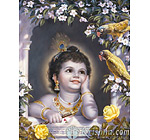

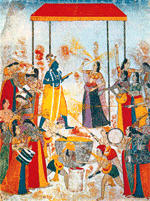
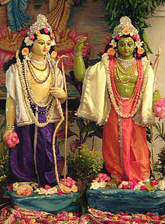

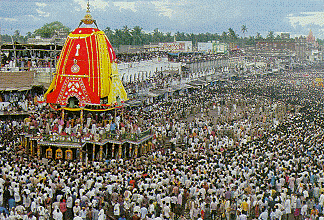
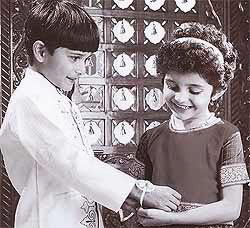
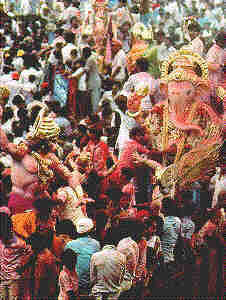
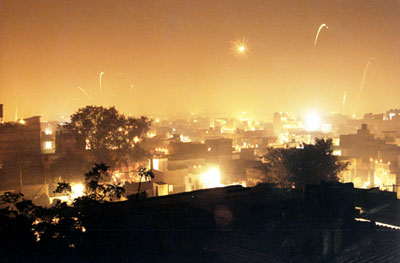
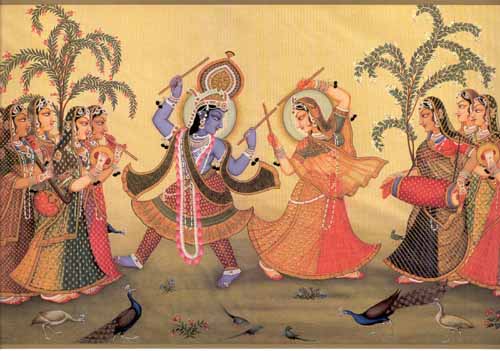
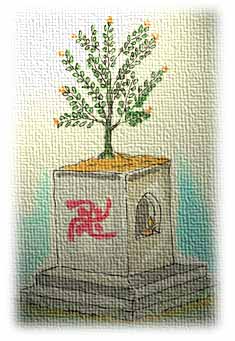
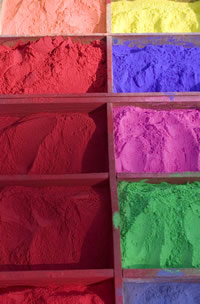
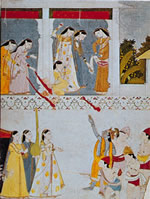
 behavior
and the resulting general atmosphere of licentious merrymaking and
ribald language and behavior. A common saying heard during Holi is
bura na mano, Holi hai ("don't feel offended, it's Holi").
behavior
and the resulting general atmosphere of licentious merrymaking and
ribald language and behavior. A common saying heard during Holi is
bura na mano, Holi hai ("don't feel offended, it's Holi").
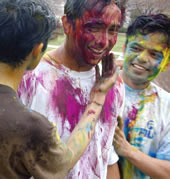 bonfire.
The fire is lit sometime between 10 PM and midnight (at the rising
of the moon), not generally in an orderly fashion. Everyone gathers
in the street for the event, and the air rings with shouts,
catcalls, curses and general mayhem.
bonfire.
The fire is lit sometime between 10 PM and midnight (at the rising
of the moon), not generally in an orderly fashion. Everyone gathers
in the street for the event, and the air rings with shouts,
catcalls, curses and general mayhem.